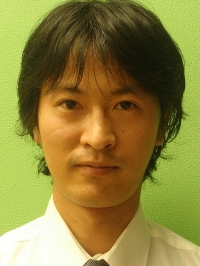Advanced Organic Materials
Staff
Research Topics
Our research interests include (1) chemistry of nanocarbons (fullerenes and carbon nanotubes), (2) chemistry of main group elements, (3) self-assembly and photoproperties of organic semiconductors, (4) chemical modification of clusters, and (5) fabrication and properties of nanohybrids.
Chemical modification of dodecaborates (Na2B12H12)
|
The functionalization of dodecaborates has attracted much attention, both for the development of boron neutron capture therapy (BNCT). We have successfully synthesized a new water‐soluble dendrimer that bears B12‐cluster terminals with potential applications in BNCT. Moreover, the physical modification of SWCNTs with boron cluster dendrimer furnished SWCNT/(boron cluster dendrimer) nanohybrids that exhibit NIR‐I‐to‐NIR‐II fluorescence. Further investigations into the cellular uptake and cytotoxicity of the materials are currently in progress. |

|
The SWCNT photocatalyst for hydrogen production from water upon photoexcitation of (8,3) SWCNT at 680-nm light
|
Single-walled carbon nanotubes (SWCNTs) are potentially strong optical absorbers with tunable absorption bands depending on their chiral indices (n, m). Their application for solar energy conversion is difficult because of the large binding energy (>100 meV) of electron-hole pairs, known as excitons, produced by optical absorption. Recent development of photovoltaic devices based on SWCNTs as light-absorbing components have shown that the creation of heterojunctions by pairing chirality-controlled SWCNTs with C60 is the key for high power conversion efficiency. In contrast to thin film devices, photocatalytic reactions in a dispersion/solution system triggered by the photoexcitation of SWCNTs have never been reported due to the difficulty of constructing a well-ordered surface on SWCNTs. Here, we show a clear-cut example of a SWCNT photocatalyst producing H2 from water. Self-organization of a fullerodendron on the SWCNT core produces water-dispersible coaxial nanowires possessing SWCNT/C60 heterojunctions, of which a dendron shell can act as support of a co-catalyst for H2 evolution. Because the band offset between the LUMO levels (8, 3) SWCNT and C60 satisfactorily exceeds the exciton binding energy to allow efficient exciton dissociation, the (8, 3) SWCNT fullerodendron coaxial photocatalyst shows H2-evolving activity (QY = 0.015) upon 680-nm illumination. |

|
Synthesis of a poly(amidoamine) dendrimer with a 1,10-bis(decyloxy)decane core, and its use in fabricating carbon nanotube/calcium carbonate hybrids through biomimetic mineralization
|
A new dendritic dispersant of carbon nanotubes (CNTs) was synthesized and applied to obtain noncovalent functionalization of single-walled carbon nanotubes (SWCNTs) and multi-walled carbon nanotubes (MWCNTs). The 1,10-bis(decyloxy)decane core of the poly(amidoamine) dendrimer strongly adhered to the sidewalls of CNTs to form CNT/dendrimer supramolecular nanocomposites having many carboxyl groups (–COOH) on the surface. Then, crystallization of calcium carbonate (CaCO3) using the CO2 diffusion technique in aqueous environments and CNT/dendrimer supramolecular nanocomposites as scaffolds afforded monodisperse spherical CNT/CaCO3 nanohybrids consisting of CNTs and calcite nanocrystals. The morphologies of the SWCNT/CaCO3 hybrids and MWCNT/CaCO3 hybrids were almost identical. |

|
Publication List
- "Dye-sensitized H2 evolution from water facilitated by photoinduced electron transfer between molecules on the inside and the outside of a carbon nanotube" Tomoyuki Tajima, Masahiro Yamagami, Ryohei Sagawa, Hideaki Miyake, and Yutaka Takaguchi, J. Appl. Phys. 2021, 129, 014303. DOI:10.1063/5.0026896
- "Photoinduced Electron Transfer in a MoS2/Anthracene Mixed-Dimensional Heterojunction in Aqueous Media" Tomoyuki Tajima, Shogo Okabe, and Yutaka Takaguchi, Bull. Chem. Soc. Jpn. 2020, 93, 745-750. DOI:10.1246/bcsj.20200026
- "Disproportionation-induced solid-state fluorescence in 6,13-dihydropentacenes" Tomoyuki Tajima, Rai Sanda, Katsuya Nishihara, Hitoshi Shirai, Yasuhiro Okuda, Akihiro Orita and Yutaka Takaguchi, RSC Adv. 2019, 9, 17035-17039. DOI:10.1039/C9RA03297E
- ”Carbon-Nanotube-based photocatalysts for Water Splitting in Cooperation with BiVO4 and [Co(bpy)3]3+/2+” Takumi Izawa, Vit Kalousek, Daiki Miyamoto, Noritake Murakami, Hideaki Miyake, Tomoyuki Tajima, Wataru Kurashige, Yuichi Negishi, Keita Ikeue, Takahiro Ohkubo, and Yutaka Takaguchi, Chem. Lett. 2019, 48, 410-413. Editor’s Choice, DOI:10.1246/cl.180999
- "Physical modification of carbon nanotubes with a dendrimer bearing terminal mercaptoundecahydrododecaborates (Na2B12H11S)" Masahiro Yamagami, Tomoyuki Tajima, Kango Ishimoto, Hideaki Miyake, Hiroyuki Michiue, Yutaka Takaguchi, Heteroatom Chem. 2018, 29, e21467. DOI:10.1002/hc.21467
- "Enhanced Photosensitized Hydrogen Production by Encapsulation of Ferrocenyl Dyes into Single-Walled Carbon Nanotubes" Noritake Murakami, Hideaki Miyake, Tomoyuki Tajima, Kakeru Nishikawa, Ryutaro Hirayama, and Yutaka Takaguchi, J. Am. Chem. Soc. 2018,140, 3821-3824.DOI:10.1021/jacs.7b12845
- "Photo-induced H2 Evolution from Water via the Dissociation of Excitons in Water-Dispersible Single-Walled Carbon Nanotube Sensitizers" Kango Ishimoto, Tomoyuki Tajima, Hideaki Miyake, Masahiro Yamagami, Wataru Kurashige, Yuichi Negishi, and Yutaka Takaguchi, Chem. Comm. 2018, 54, 393-396. DOI:10.1039/C7CC07194A
- "A Facile Synthesis of a SnO2/Graphene Oxide Nano-Nano Composite and its Photoreactivity" Tomoyuki Tajima, Haruko Goto, Masayasu Nishi, Takahiro Okubo, Yuta Nishina, Hideaki Miyake, and Yutaka Takaguchi, Mater. Chem. Phys. 2018, 212, 149–154. DOI:10.1016/j.matchemphys.2018.03.046
